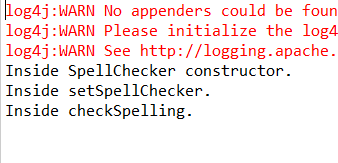Spring(五)之Bean定义继承和依赖注入
一、Bean定义继承
bean定义可以包含许多配置信息,包括构造函数参数,属性值和特定于容器的信息,例如初始化方法,静态工厂方法名称等。
子bean定义从父定义继承配置数据。子定义可以根据需要覆盖某些值或添加其他值。
Spring Bean定义继承与Java类继承无关,但继承概念是相同的。您可以将父bean定义定义为模板,其他子bean可以从父bean继承所需的配置。
使用基于XML的配置元数据时,可以使用parent属性指定子bean定义,并将父bean指定为此属性的值。
演示示例:
(1)编写HelloWorld.java
package com.tutorialspoint;
public class HelloWorld {
private String message1;
private String message2; public void setMessage1(String message){
this.message1 = message;
}
public void setMessage2(String message){
this.message2 = message;
}
public void getMessage1(){
System.out.println("World Message1 : " + message1);
}
public void getMessage2(){
System.out.println("World Message2 : " + message2);
}
}
(2)编写HelloIndea.java
package com.tutorialspoint;
public class HelloIndia {
private String message1;
private String message2;
private String message3;
public void setMessage1(String message){
this.message1 = message;
}
public void setMessage2(String message){
this.message2 = message;
}
public void setMessage3(String message){
this.message3 = message;
}
public void getMessage1(){
System.out.println("India Message1 : " + message1);
}
public void getMessage2(){
System.out.println("India Message2 : " + message2);
}
public void getMessage3(){
System.out.println("India Message3 : " + message3);
}
}
(3)编写MainApp.java
package com.tutorialspoint; import org.springframework.context.ApplicationContext;
import org.springframework.context.support.ClassPathXmlApplicationContext; public class MainApp {
public static void main(String[] args) {
ApplicationContext context = new ClassPathXmlApplicationContext("Beans.xml"); HelloWorld objA = (HelloWorld) context.getBean("helloWorld");
objA.getMessage1();
objA.getMessage2(); HelloIndia objB = (HelloIndia) context.getBean("helloIndia");
objB.getMessage1();
objB.getMessage2();
objB.getMessage3();
}
}
(4)Beans.xml
<?xml version = "1.0" encoding = "UTF-8"?> <beans xmlns = "http://www.springframework.org/schema/beans"
xmlns:xsi = "http://www.w3.org/2001/XMLSchema-instance"
xsi:schemaLocation = "http://www.springframework.org/schema/beans
http://www.springframework.org/schema/beans/spring-beans-4.0.xsd"> <bean id = "helloWorld" class = "com.tutorialspoint.HelloWorld">
<property name = "message1" value = "Hello World!"/>
<property name = "message2" value = "Hello Second World!"/>
</bean> <bean id ="helloIndia" class = "com.tutorialspoint.HelloIndia" parent = "helloWorld">
<property name = "message1" value = "Hello India!"/>
<property name = "message3" value = "Namaste India!"/>
</bean> </beans>
(5)运行MainApp.java中的main方法

二、依赖注入
每个基于Java的应用程序都有一些对象可以协同工作,以呈现最终用户所看到的工作应用程序。在编写复杂的Java应用程序时,应用程序类应尽可能独立于其他Java类,以增加重用这些类的可能性,并在单元测试时独立于其他类测试它们。依赖注入(或称为布线)有助于将这些类粘合在一起,同时保持它们的独立性。
依赖注入常用两种形式:
1.set注入(比较常用)
2.构造函数注入
set注入示例:
(1)编写TextEditor.java
package com.tutorialspoint;
public class TextEditor {
private SpellChecker spellChecker;
// a setter method to inject the dependency.
public void setSpellChecker(SpellChecker spellChecker) {
System.out.println("Inside setSpellChecker." );
this.spellChecker = spellChecker;
}
// a getter method to return spellChecker
public SpellChecker getSpellChecker() {
return spellChecker;
}
public void spellCheck() {
spellChecker.checkSpelling();
}
}
(2)编写SpellChecker.java
package com.tutorialspoint;
public class SpellChecker {
public SpellChecker(){
System.out.println("Inside SpellChecker constructor." );
}
public void checkSpelling(){
System.out.println("Inside checkSpelling." );
}
}
(3)编写Beans.xml
<?xml version = "1.0" encoding = "UTF-8"?> <beans xmlns = "http://www.springframework.org/schema/beans"
xmlns:xsi = "http://www.w3.org/2001/XMLSchema-instance"
xsi:schemaLocation = "http://www.springframework.org/schema/beans
http://www.springframework.org/schema/beans/spring-beans-4.0.xsd"> <!-- Definition for textEditor bean using inner bean -->
<bean id = "textEditor" class = "com.tutorialspoint.TextEditor">
<property name = "spellChecker">
<bean id = "spellChecker" class = "com.tutorialspoint.SpellChecker"/>
</property>
</bean> </beans>
(4)编写MainApp.java
package com.tutorialspoint; import org.springframework.context.ApplicationContext;
import org.springframework.context.support.ClassPathXmlApplicationContext; public class MainApp {
public static void main(String[] args) {
ApplicationContext context = new ClassPathXmlApplicationContext("Beans.xml");
TextEditor te = (TextEditor) context.getBean("textEditor");
te.spellCheck();
}
}
(5)运行MainApp.java中的main方法

2.注入集合
Spring提供四种集合注入方式:
(1)Set;(2)List;(3)Map;(4)Props;
演示示例如下:
(1)编写JavaCollection
package com.tutorialspoint;
import java.util.*; public class JavaCollection {
List addressList;
Set addressSet;
Map addressMap;
Properties addressProp; // a setter method to set List
public void setAddressList(List addressList) {
this.addressList = addressList;
} // prints and returns all the elements of the list.
public List getAddressList() {
System.out.println("List Elements :" + addressList);
return addressList;
} // a setter method to set Set
public void setAddressSet(Set addressSet) {
this.addressSet = addressSet;
} // prints and returns all the elements of the Set.
public Set getAddressSet() {
System.out.println("Set Elements :" + addressSet);
return addressSet;
} // a setter method to set Map
public void setAddressMap(Map addressMap) {
this.addressMap = addressMap;
} // prints and returns all the elements of the Map.
public Map getAddressMap() {
System.out.println("Map Elements :" + addressMap);
return addressMap;
} // a setter method to set Property
public void setAddressProp(Properties addressProp) {
this.addressProp = addressProp;
} // prints and returns all the elements of the Property.
public Properties getAddressProp() {
System.out.println("Property Elements :" + addressProp);
return addressProp;
}
}
(2)编写Beans.xml
<?xml version = "1.0" encoding = "UTF-8"?> <beans xmlns = "http://www.springframework.org/schema/beans"
xmlns:xsi = "http://www.w3.org/2001/XMLSchema-instance"
xsi:schemaLocation = "http://www.springframework.org/schema/beans
http://www.springframework.org/schema/beans/spring-beans-4.0.xsd"> <!-- Definition for javaCollection -->
<bean id = "javaCollection" class = "com.tutorialspoint.JavaCollection"> <!-- results in a setAddressList(java.util.List) call -->
<property name = "addressList">
<list>
<value>INDIA</value>
<value>Pakistan</value>
<value>USA</value>
<value>USA</value>
</list>
</property> <!-- results in a setAddressSet(java.util.Set) call -->
<property name = "addressSet">
<set>
<value>INDIA</value>
<value>Pakistan</value>
<value>USA</value>
<value>USA</value>
</set>
</property> <!-- results in a setAddressMap(java.util.Map) call -->
<property name = "addressMap">
<map>
<entry key = "1" value = "INDIA"/>
<entry key = "2" value = "Pakistan"/>
<entry key = "3" value = "USA"/>
<entry key = "4" value = "USA"/>
</map>
</property> <!-- results in a setAddressProp(java.util.Properties) call -->
<property name = "addressProp">
<props>
<prop key = "one">INDIA</prop>
<prop key = "one">INDIA</prop>
<prop key = "two">Pakistan</prop>
<prop key = "three">USA</prop>
<prop key = "four">USA</prop>
</props>
</property>
</bean> </beans>
(3)编写MainApp.java
package com.tutorialspoint; import org.springframework.context.ApplicationContext;
import org.springframework.context.support.ClassPathXmlApplicationContext; public class MainApp {
public static void main(String[] args) {
ApplicationContext context = new ClassPathXmlApplicationContext("Beans.xml");
JavaCollection jc=(JavaCollection)context.getBean("javaCollection"); jc.getAddressList();
jc.getAddressSet();
jc.getAddressMap();
jc.getAddressProp();
}
}
(4)运行MainApp.java中的main方法
结果如下:

Spring(五)之Bean定义继承和依赖注入的更多相关文章
- spring学习五:Spring Bean 定义继承
Bean 定义继承 bean 定义可以包含很多的配置信息,包括构造函数的参数,属性值,容器的具体信息例如初始化方法,静态工厂方法名,等等. 子 bean 的定义继承父定义的配置数据.子定义可以根据需要 ...
- 品Spring:负责bean定义注册的两个“排头兵”
别看Spring现在玩的这么花,其实它的“筹码”就两个,“容器”和“bean定义”. 只有先把bean定义注册到容器里,后续的一切可能才有可能成为可能. 所以在进阶的路上如果要想走的顺畅些,彻底搞清楚 ...
- Spring IOC源代码具体解释之容器依赖注入
Spring IOC源代码具体解释之容器依赖注入 上一篇博客中介绍了IOC容器的初始化.通过源代码分析大致了解了IOC容器初始化的一些知识.先简单回想下上篇的内容 加载bean定义文件的过程.这个过程 ...
- Spring升级案例之IOC介绍和依赖注入
Spring升级案例之IOC介绍和依赖注入 一.IOC的概念和作用 1.什么是IOC 控制反转(Inversion of Control, IoC)是一种设计思想,在Java中就是将设计好的对象交给容 ...
- Spring-初识Spring框架-IOC控制反转(DI依赖注入)
---恢复内容开始--- IOC :控制反转 (DI:依赖注入)使用ioc模式开发 实体类必须有无参构造方法1.搭建Spring环境下载jarhttp://maven.springframework. ...
- 三大框架 之 Spring(IOC控制反转、DI依赖注入)
目录 常用词汇 left join与left outer join的区别 Struts2的标签库导入 Spring Spring概述 什么是Spring spring特点 下载 IOC 什么IOC 传 ...
- spring接口多实现类,该依赖注入哪一个?
一.问题的描述 在实际的系统应用开发中我经常会遇到这样的一类需求,相信大家在工作中也会经常遇到: 同一个系统在多个省份部署. 一个业务在北京是一种实现方式,是基于北京用户的需求. 同样的业务在上海是另 ...
- Spring详解(三)------DI依赖注入
上一篇博客我们主要讲解了IOC控制反转,也就是说IOC 让程序员不在关注怎么去创建对象,而是关注与对象创建之后的操作,把对象的创建.初始化.销毁等工作交给spring容器来做.那么创建对象的时候,有可 ...
- Java框架spring 学习笔记(五):Bean定义继承
子 bean 的定义继承父定义的配置数据.子定义可以根据需要重写一些值,或者添加其他值. 编写HelloWorld.java package com.example.spring; public cl ...
随机推荐
- HBase—列族数据库的术语
1. 列族数据库的基本组件 键空间,行键,列,列族 2. 什么是键空间 keyspace? 键空间 keyspace 是列族数据库的顶级数据结构,它在逻辑上能够容纳列族,行键以及与之相关的其他数据结构 ...
- java语言的各种输入情况(ACM常用)
1.只输入一组数据: Scanner s=new Scanner(System.in); int a=s.nextInt(); int b=s.nextInt(); 2.输入有多组数据,没有说明输入几 ...
- java设计模式-----4、单例模式
单例模式是一种对象创建型模式,使用单例模式,可以保证为一个类只生成唯一的一个实例对象.也就是说,在整个程序空间中,该类只存在一个实例对象. 其实,GoF对单例模式的定义是:保证一个类,只有一个实例存在 ...
- HTML5 Web存储 页面间进行传值
在实际使用过程中,经常会遇到需要在页面间进行传值的情况,最初设想一定需要后端才能进行数据的存储和读取,或者在本地使用一个cookie进行保存,直到了解到HTML5 Web存储 使用HTML5的新特性可 ...
- Angular面试题二
十一.ng-repeat迭代数组的时候,如果数组中有相同值,会有什么问题,如何解决? 会提示 Duplicates in a repeater are not allowed. 加 track by ...
- ARCGIS 10.0破解版安装过程error 1606 和error 1316问题 及安装流程
来自:http://blog.csdn.net/don_lvsml/article/details/8681100 楼主今天安装ESRI.ArcGIS.10.CS时,由于第一次接触该软件,将其按照一般 ...
- apple 下安装mysql 以及 碰到的问题
直接说过程: 1.从mysql 官网下载 mysql 5.7最新版:有 两种 一种是 dmg 的傻瓜包,一种是tar.gz的压缩包.我下载的是tar.gz的压缩包. 2.下载成功后,先试用命令sudo ...
- 监控事件日志关键字规则(EventDescription)
新建规则--基于NT事件日志--自定义条件:EventDescription - 包含 - 关键字
- magento2常见的命令
常见的命令如下: php bin/magento list 查看所有命令列表 ----------------------------moudule相关的参数------------------ ...
- [BZOJ 3992][SDOI2015]序列统计
3992: [SDOI2015]序列统计 Time Limit: 30 Sec Memory Limit: 128 MBSubmit: 2275 Solved: 1090[Submit][Stat ...
